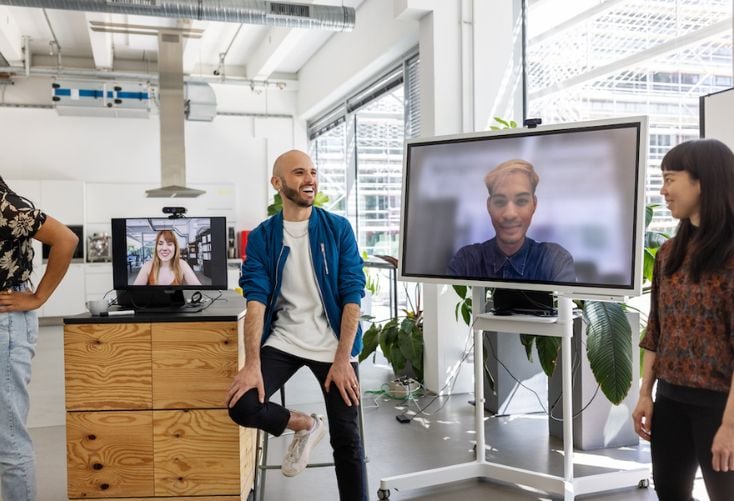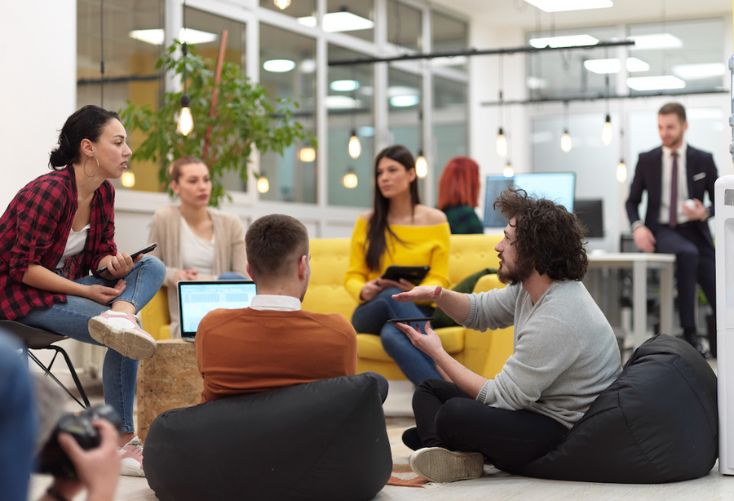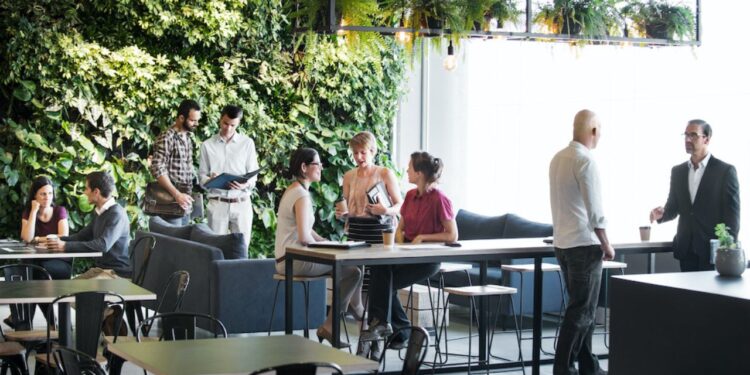- The companies that embrace hybrid work and human-centric workplace practices at scale will be best equipped to support continuous workplace change over time.
- Progressive organizations are acting upon the fundamental belief that truly understanding the customer (employee) and providing an amazing user experience will increase demand for the workplace product.
- Developing a human-centric workplace means offering hybrid working to the majority of employees who crave greater flexible work options.
This article was written by Peter Miscovich, and was originally published on Work Design Magazine.
As the tectonic evolution toward hybrid work continues to reshape work behaviors across all sectors, leading companies today are focused upon delivering human-centric workplaces—with an emphasis upon hybrid working. From initially assuming a business-as-usual return to the centralized corporate office, many organizations have pivoted toward individualistic workplace design that further enhances the human experience and delivers superior workplace performance.
Leading organizations today are adopting work design approaches that seek to fulfill individual employee needs and support diverse work behaviors within an evergreen, yet continuously evolving, hybrid workplace ecosystem. These organizations are reimagining their workplaces, creating entirely new types of workspaces to support evolving individual and team needs. The companies that embrace hybrid work and human-centric workplace practices at scale will be best equipped to support continuous workplace change over time.
The shift to human-centric work began decades before the pandemic, as companies faced critical talent shortages and began to experiment with flexible workplace strategies—including coworking—and innovative workplace ecosystems that would help to attract, recruit and retain essential digital talent. The global shift to remote work at scale during the pandemic accelerated human-centric workplace trends as companies were compelled to experiment, test and explore new ways of hybrid working.
Moving forward, the human-centric workplace will become mainstream as employers begin to recognize that employees are akin to “consumers” who need a strong and compelling reason to come to the office to “consume” the corporate office. Borrowing a page from the consumer marketing playbook, progressive organizations are acting upon the fundamental belief that truly understanding the customer and providing an amazing user experience will increase demand for the workplace product.
Rather than viewing their workplaces simply as a cost center, progressive companies have begun to view the office as an important business tool that can provide peak human experiences, enable “magical moments of collaboration” and meet the employee desire for a greater sense of purpose and belonging to an organization. These organizations are creating compelling workplaces rich with desirable experiences.
 Hybrid Working as a Foundation of The Human-Centric Workplace
Hybrid Working as a Foundation of The Human-Centric Workplace
Human-centric work design begins with reimagining the nine-to-five workday, and questioning the notion that in-office working is the only productive workplace performance modality, according to Graham Waller, a distinguished executive and analyst at Gartner. Rather than setting arbitrary policies, organizations must now seek to maximize intentional flexibility for their workers and teams within the context of the work to be done, as Waller proposed at the 2022 Gartner Symposium/ITxpo.
Hybrid working will likely be part of most organizations’ workplace strategies. According to JLL’s Workforce Barometer 2022 research, 60% of employees prefer hybrid working for the foreseeable future. IDC predicts that 70% of organizations will adopt hybrid working by 2025. Meanwhile, a recent survey by The Conference Board shows that nearly half of CEOs globally are promoting the hybrid work model to attract, recruit and retain employees.
As Gartner Vice President George Penn has said, where, and when, work gets done will be determined by what makes the most sense to drive the highest levels of productivity and engagement. In addition, managers must trust that employees will deliver upon the goals that have been set with their teams—and managers must trust that their employees will work effectively and productively to meet these business goals and performance objectives, regardless of their physical work locations.
 Progressive Human-Centric Workplaces Designed for the People
Progressive Human-Centric Workplaces Designed for the People
Clearly, developing a human-centric workplace means offering hybrid working to the majority of employees who crave greater flexible work options. Alongside the shift to hybrid working, human-centric workplace design must align to an organization’s purpose, brand, image and values.
Workplace functionality is important, of course—but so is inspiring workplace design that meets the essential needs of employees. Common features include high-quality design aesthetics, dynamic socialization areas, plentiful natural light and sound-absorbing materials that reduce noise and distraction.
Employees desire amenities and environments that foster community, connection and collaboration, and that support health and wellbeing. Workplace features that were novel before the pandemic—including innovation hubs, focus rooms and work cafes—have become the expected “new normal” baseline among leading companies.
Human-centric furnishings are designed with comfort in mind, typically with a strong hospitality or residential feel in diverse layouts. Many organizations are choosing to create an environment similar to that of a clubhouse or boutique hotel: engaging, stimulating and even entertaining.
Workplace design options may include assigned and unassigned work settings, private phone booths, huddle video tables and plentiful casual seating areas. Other important elements are communal dining spaces, cafes, break rooms, lounges, terraces, roof decks and other socialization spaces—the leading types of space for boosting employee engagement, according to JLL research.
To demonstrate the possibilities of the hybrid workplace, Steelcase has re-designed and reimagined its WorkLife New York office around the concept of human-centric design. Its three floors include focus rooms with a variety of seating options, as well as social hubs, including the WorkCafe and The Front Porch, with digital whiteboards and technology tools for different modes of work, collaboration and socializing with customers and colleagues. The “Skybox,” teaming area with visual and acoustic privacy, is where Steelcase’s New York team goes to collaborate and innovate.
By providing a variety of engaging workspaces, an organization can aim to reinforce culture and to attract people to the office for collaborative work and interactions with colleagues. Concurrently, an organization can uncover opportunities to optimize the corporate real estate portfolio and ensure that all corporate workplace locations are high-performing environments providing peak experiences with exceptional value.
 The Human-Centric Workplace Must Respond to Evolving Needs
The Human-Centric Workplace Must Respond to Evolving Needs
Leading companies are becoming increasingly strategic and intentional in creating human-centric workplace policies and design practices that meet the evolving demands of diverse employees. More than a few companies, such as Yelp, have completely relinquished their office space, finding, as Yelp did, that teams were just as productive—if not more so—without working each day within the corporate office.
However, many thoughtful C-suite leadership teams recognize that employee preferences vary widely from person to person, from city to city, and from country to country—requiring a diverse workplace ecosystem and a willingness to pilot new approaches. The dramatic reconsideration of the office requires continuous experimentation and “intentional” prototyping with thoughtful leadership attention to employee sensing, with continuous employee feedback to influence iterative hybrid workplace experimentation.
While policies will naturally vary from organization to organization, some essential practices are beginning to emerge. Microsoft’s 2022 Work Trend Index found, for example, that 38% of hybrid employees say their biggest challenge is knowing when and why to come to the office. Only 28% of leaders have created team agreements defining why and when to go to the office.
Often, an individual may belong to multiple teams, including a team of peers and their manager; their direct reports; and possibly a scrum team. Hybrid working agreements will vary and will need to change over time, since some teams need to meet and interact with more regularity and intensity than other teams within the organization.
 Integrated Technologies Will Enable Human-Centric Workplace Performance
Integrated Technologies Will Enable Human-Centric Workplace Performance
The human-centric workplace requires an intuitive, digitally enabled user experience (UX) that engages and delights the employee as the primary customer. Integrated “smart” workplace technologies will be essential to inspire employees and seamlessly connect remote and hybrid workers. A range of workplace technologies are emerging to create a single, seamless experience for employees regardless of work settings, with greater personalization of every space and attention to managing health and wellbeing.
Most organizations already use one or more video digital collaboration platforms to bring together remote and on-site employees. Many have adopted digital communications channels, such as Microsoft Teams, Slack, or discussion management software such as ThoughtExchange, to provide real-time channels with more agility and less formality than email. Such companies as Accenture, Meta and Microsoft are now introducing extended reality “metaverse” immersive collaboration platforms that will create an even more immersive and engaging digital employee experience.
 Learning Mindset Required for Human-Centric Leadership
Learning Mindset Required for Human-Centric Leadership
Creating peak workplace experiences means not only thoughtful investments in workplace design, but also in workplace technologies to bridge remote and onsite workers, and in responsive, empathetic and thoughtful policies that foster inclusion and equity across the workforce while helping retain talent. Human-centric leaders must embrace workplace experimentation with a learning mindset while adapting to ongoing business change and the demands of the next-generation workforce.
Navigating the journey to more experiential hybrid workplace ecosystems will require new leadership skills for managing experimentation across multiple global business groups and diverse geographies. The next-generation workplace will require significant integration of workplace/facilities, real estate, human resources, information technology (IT) and executive leadership functions—all working in concert to develop and execute human-centric, hybrid workplace programs at scale.
Just like a consumer product, the hybrid workplace must be continuously refreshed to respond to evolving employee needs and “evergreen” changing employee preferences.
Through ongoing cross-disciplinary enterprise functional collaboration (between business leadership, HR, IT, corporate real estate, finance etc…) combined with the monitoring and sensing of evolving employee work preferences, leading organizations will be able launch, implement and sustain their human-centric hybrid workplace programs at scale successfully.


 Dr. Gleb Tsipursky – The Office Whisperer
Dr. Gleb Tsipursky – The Office Whisperer Nirit Cohen – WorkFutures
Nirit Cohen – WorkFutures Angela Howard – Culture Expert
Angela Howard – Culture Expert Drew Jones – Design & Innovation
Drew Jones – Design & Innovation Jonathan Price – CRE & Flex Expert
Jonathan Price – CRE & Flex Expert















